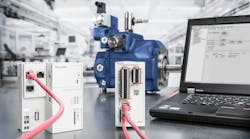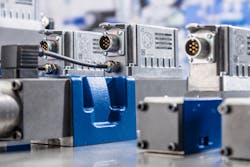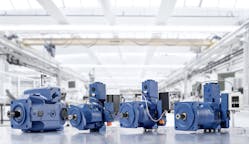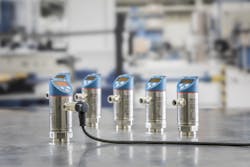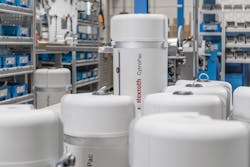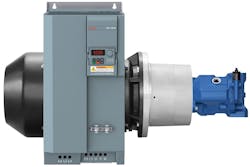I keep hearing the same thing: “We want people to know that there is still a future in Manufacturing.” “We want people to see manufacturing the way it is today, and not the dark, dirty factories some people still envision.” I’ve heard this from many companies—and on this particular occasion, from representatives of Bosch Rexroth as they gave me a personal tour of their facility in Bethlehem, Pa.
Last year marked Bosch Rexroth’s 50th year of continuous operation in the United States. It started with a small office in Easton, Pa. in 1967, and then a few years later moving to the Bethlehem facility at 2315 City Line Rd. Now it is a campus, and is the keystone of the company’s operations in the U.S.
With precision electric motors, and the cost of stepper and servomotors being reduced year after year, is it just a matter of time until hydraulics are phased out? No, that’s a silly question. Where hydraulics may see erosion toward electrical drives is in rotary type applications.
Modern directional control valves offer integrated electronics or separate amplifiers for easy integration into a Smart Fluid Power concept. (Shown here: Rexroth Directional Control Valves 4WRLE, 4WRPEH, and 4WRPE.)
However, according to Jon Frey, head of engineered systems and solutions at BR, “For linear drives, hydraulics will prevail. Of course, low tonnage, clean room applications such as medical packaging, may elect mechanical or electric drives over hydraulic. But as loads, distances, and possibly even deteriorating environments increase, hydraulic solutions for linear axis remain strong.” Applications that need power density or a lot of power per dollar spent, hydraulics are not easily matched.
In addition, Hydraulics are becoming more sensitive, accurate, and variable. In short, they are getting smarter. Companies are selling sensor packages and retrofit solutions that offer feedback, position data, and more. This helps a company “dip its toe in,” before making a move to integrate more smart devices of an embedded machine.
This also provides data so a company can start to see where a smart device would have the greatest impact. Data can also show to what degree of intelligence is needed in a system. Perhaps a few retrofitted devices are all that is needed for now. Maybe the data will show replacing equipment with fully integrated machines will actually yield the best ROI. One thing that is known is that without data, it can be hard to know what to look for or where to start.
The power density of hydraulics is not easily matched by other technologies.
What to Look For
At the beginning of the tour, I saw some of the technology BR using. Integrated sensors, the extensiveness of the hydraulics, and electronics/electric controls portfolio permit BR to bundle electro-hydraulic components/sub-systems with higher-level IoT gateways and open core engineering capability.
Integrated sensors can also be utilized in cataloging operational characteristics and internal monitoring of critical components (e.g., high-torque, low-speed, large displacement motors). Continual monitoring of key attributes allows us to flag undesirable conditions, make recommendations for service intervals, and seek maintenance contracts and similar business model development beyond the initial component/system sale.
By combining hydraulic components with temperature, vibration, and flow sensors, smart hydraulics can also provide immediacy in system health, either for an individual component level or within a collated i4.0 (smart factory) premise. Adoption of QR codes and/or similar sensors permits customers to scan for data sheets and/or replacement parts (filter elements). With brand-developed apps (e.g., Rexroth’s GoTo Products App, Fit4Filter, or Go-Axial), access to information is 24/7 and driven by the customer’s timeline—not standard business operational hours.
Digitally-enabled pressure switches with IO-Link: the integration of fluid technology in Industry 4.0 applications as IO-Link enables vertical connection of components all the way into IT systems.
Where to Start
As the Industrial Internet of Things (or Industry 4.0) started, it was apparent that many applications didn’t need much data to start finding trends and where improvement can be made. Vibration, temperature, and voltage feedback could offer enough feedback data. This is a good place to start: the least amount of data needed to determine where the most value will be found if given more connectivity.
Frey mentioned that some low-hanging fruit comes via new features such as variable-speed drives (either DC-servo driven or via a frequency converter). Adoption of these technologies permits applications utilizing fixed displacement pumps to extract operational benefits toward power consumption savings, versus running at or near peak horsepower continuously.
Escalation of this technology through variable displacement pumps and related controllers permit aligning machine or process parameters toward providing only the output of energy given the conditions required. In plant conditions where there are multiple, similar stations, connectivity through plant level bus architecture may also yield staged ramping in of stations to flatten power consumption curves/peak draws.
As more solutions lean toward connectivity, smart manufacturing and areas around the Industrial Internet of Things will continue to grow stronger and find their way into an ever-expanding range of products, applications, and data harvesting capabilities. Engineers will have to understand and follow the migration from past structures of “ladder logic” toward current programming methodologies. The changes from strict mechanical, electrical, and hydraulics toward electro-hydraulic/electro-mechanical products and solutions will continue to happen. Engineers who follow this trend and have more electrical and/or programming skills will become increasing valuable.
While pre-packaged solutions, such as CytroPac, are always available, a company should set target goals for successful implementation of a smart fluid plan.
One suggestion for those embarking upon the path of smart fluid power would be to select a partner which can offer blended solutions. The brand that is adept at electrics/electronics, hydraulics, and mechatronics can be a powerful partner in developing applicable solutions to unique parameters. We believe it will be some time before all of the connected products “speak” the same language and data analytics will interpret completely the wide scope of nuances which will be harvested.
“In our experience, there is no one universal solution,” says Frey. “While there are always pre-packaged solutions available, such as Cytropac and/or Sytronix, a company should set target goals toward what is a successful implementation. Successful implementation could look like a quick win or fast return on investment, part of a longer-term roll-out, interest in participating in state, or federal government rebates/carbon credit, etc.”
Adoption of variable-speed drives permits applications utilizing fixed displacement pumps to extract operational benefits toward power consumption savings.
Another thing to consider is if the kind of data harvested is to be solely within your control, if you wish to involve a third-party data analytic partner, or if the data is to reside in a cloud. For example, harvested data with no purpose or goal is of little use in making effective, proactive decisions with respect to preventive maintenance, health monitoring, process monitoring/sampling, etc.
